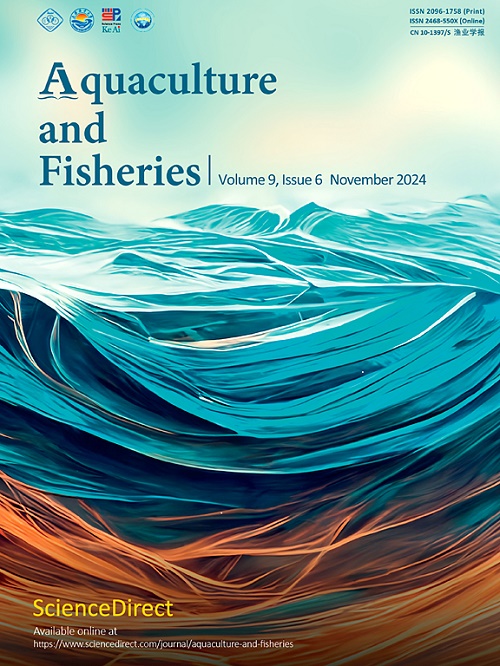Age, growth and length-to-weight relationship of largehead hairtail (Trichiurus lepturus) in south-eastern Australia suggest a distinct population
Q1 Agricultural and Biological Sciences
引用次数: 0
Abstract
The age, growth rates and length to weight relationships for the south-eastern Australian population of largehead hairtail (Trichiurus lepturus) were investigated for the first time. Age was estimated by counting annuli in sectioned sagittal otoliths, with a maximum age of 8 years estimated for males and females. We found no significant differences in the growth rates of males and females over the size (12–78 cm pre-anal length (PL)) and age (0–8 years) ranges sampled. However, females in our collection were larger on average than males, and all fish sampled >60 cm PL were female, suggesting that females may grow to larger sizes than males and that sampling of greater numbers of larger and older fish may be required in future. T. lepturus growth was described by the von Bertalanffy growth function parameters L∝ = 74.89 cm PL, K = 0.13yr−1 and t0 = −0.80 yr, with the L∝ being amongst the largest reported for the species. Growth was variable, with the sizes at any given age spanning up to 50 cm PL. Female T. lepturus increased in body weight relative to length faster than males, as has been reported in other populations. The length/weight relationship for the south-eastern Australian population was significantly different, with almost no overlap, from that reported for T. lepturus in the Arabian Sea. The substantial differences in growth rates, maximum sizes and body morphometrics of T. lepturus from south-eastern Australia in comparison to other populations globally are consistent with the hypotheses that it represents a distinct population, although investigations using additional population markers are required to verify this.
澳大利亚东南部大头带鱼(Trichiurus lepturus)的年龄、生长和长重关系表明它是一个独特的种群
首次对澳大利亚东南部大头带鱼种群的年龄、生长率和长重关系进行了调查。通过计算矢状面耳石上的环空来估计年龄,估计男性和女性的最大年龄为8岁。我们发现雄性和雌性在大小(12-78 cm肛前长度(PL))和年龄(0-8岁)范围内的生长速度没有显著差异。然而,我们收集的雌鱼平均比雄鱼大,并且所有取样的>;60 cm PL的鱼都是雌鱼,这表明雌鱼可能比雄鱼长得更大,未来可能需要取样更多数量的更大和更老的鱼。用von Bertalanffy生长函数参数L∝= 74.89 cm PL, K = 0.13yr - 1和t0 = - 0.80 yr来描述lepturus的生长,其中L∝是该物种中最大的。生长是可变的,在任何给定的年龄,大小可达50厘米。正如在其他种群中报道的那样,雌性lepturus的体重相对于长度的增长速度比雄性快。东南澳大利亚种群的长度/重量关系与阿拉伯海的T. lepturus有显著不同,几乎没有重叠。与全球其他种群相比,澳大利亚东南部的lepturus在生长速度、最大体型和身体形态计量学上的巨大差异与它代表一个独特种群的假设是一致的,尽管需要使用额外的种群标记进行调查来验证这一点。
本文章由计算机程序翻译,如有差异,请以英文原文为准。
求助全文
约1分钟内获得全文
求助全文
来源期刊

Aquaculture and Fisheries
Agricultural and Biological Sciences-Aquatic Science
CiteScore
7.50
自引率
0.00%
发文量
54
审稿时长
48 days
期刊介绍:
 求助内容:
求助内容: 应助结果提醒方式:
应助结果提醒方式:


